I disposed of the lead fragment and picked through the rest of the venison carefully. I hoped none of my bullets would ever come apart like that again.
Tag: delusions of separation
Coyotes, deer, and the very idea of ‘game’
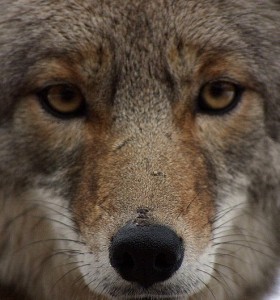
A few nights ago, coyotes yipped and howled nearby. I was delighted to hear them.
Granted, I was in bed at the time. My sentiments would, I suspect, be substantially different if I was, say, deep in the woods with a turned ankle and no flashlight.
The next day I got thinking about those wild yelps, and about coyotes.
Here in Vermont, some hunters are happy to have coyotes around, and never think of killing them. Other hunters despise coyotes and shoot them at every opportunity. Still others are somewhere in the middle: perhaps ambivalent, perhaps hunting them occasionally, perhaps happy to co-exist as long as Fido and Sylvester aren’t getting snatched from the backyard.
These hunters would, I imagine, respond in various ways to Aldo Leopold’s thoughts about predators on the land:
Harmony with land is like harmony with a friend; you cannot cherish his right hand and chop off his left. That is to say, you cannot love game and hate predators; you cannot conserve the waters and waste the ranges; you cannot build the forest and mine the farm. The land is one organism.

What catches my eye in that passage is the word “game.”
As a broad category, of course, it simply indicates creatures that we hunt or catch. “Game” says deer, not shrew. It says grouse, not egret. It says bass, not minnow.
But doesn’t it also say something else?
By saying “game,” don’t we stake some kind of claim on these creatures? Don’t we define them as somehow different from other “wildlife,” perhaps one step closer to “livestock,” to “property”?
When hunters talk about what impact coyotes do or don’t have on white-tailed deer numbers, isn’t the entire discussion built on the very idea of “game”? On the notion that deer—almost like cows and sheep, or Fido and Sylvester—are, at least in part, off-limits to coyotes?
What are the consequences of believing that certain wild animals should be killed and eaten only—or at least mostly—by two-footed predators, not four-footed?
© 2010 Tovar Cerulli
Snake food: Humans as prey
The sound was quiet, but close: a rustle in the leaves a few feet from the hiking trail.
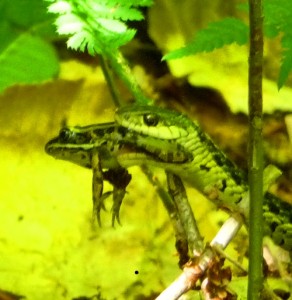 Curious, I peered under the ferns and caught sight of a garter snake. Then I saw what it was up to.
Curious, I peered under the ferns and caught sight of a garter snake. Then I saw what it was up to.
Not one of Mr. Frog’s better days.
The image of the amphibian in that reptile’s maw reminds me of the gargantuan snakeskin my father had when I was a boy. He had inherited it from some great-aunt who had traveled overseas. I suspect it was a reticulated python.
Now and then, I would take it out of the closet and unfurl it, fold by fold, until I had the entire skin—some twelve to fifteen inches wide and twenty-plus feet long—stretched across the ground. The desiccated skull, still attached, smelled faintly of stale decay.
I was fascinated by the sheer size of the thing.
I knew that snakes this large could eat pigs. Why not a small boy?
Examining that snakeskin was one of my earliest encounters with the idea of humans as potential prey. Not just creatures inevitably recycled in the web of life, as I touched on in one of my first blog posts, but creatures potentially hunted and eaten. For most of the last hundred millennia, Homo sapiens devoted a good deal of attention to avoiding other predators. In some parts of the world, we still have to be careful.
As a hunter, I wonder: What would it be like to end as prey?
That depends, I suppose, on how swiftly the predator accomplishes its lethal aim. The frog in the photo looks calm enough, but I don’t relish the thought of death by digestion. Faster than cancer, to be sure, but not exactly appealing.
Death by grizzly, though? Or by cougar? Given the option, those are tickets I might take.
© 2010 Tovar Cerulli
‘I could definitely kill one of those’
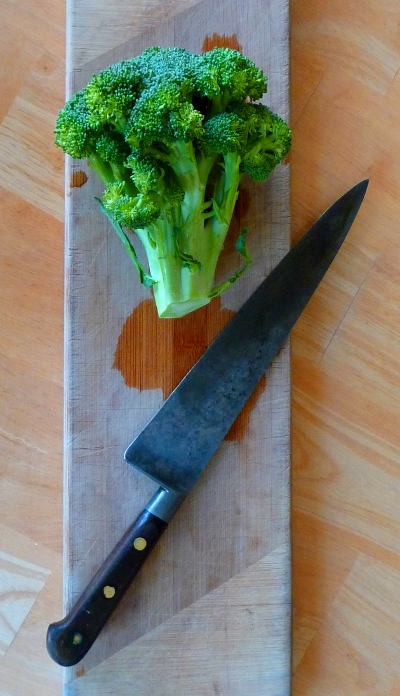 The timing was dead-on.
The timing was dead-on.
Just as I walked past the table, the woman said, “My rule is, ‘I’ll only eat it if I could kill it.’ And I could definitely kill one of those.”
I left the restaurant chuckling. I was thinking how the line echoed one of my reasons for taking up hunting: to face the killing of the fellow vertebrates I had begun eating after a decade of abstention. There would, I felt, be a lesson in that confrontation.
But the line also reminded me how complex our eating is.
As a vegan, my rule had been like hers. I was unwilling to kill animals or keep them penned up—or to have someone else do the killing or penning for me—so I didn’t eat their flesh or even their eggs or milk. I was okay with the killing of vegetables, grains, and legumes. Whether I grew it myself or bought it, the question seemed simple: Was I willing to behead broccoli?
Eventually, though, I came to the uncomfortable realization that harvesting individual plants was not all it took to put vegetarian meals on my plate.
- Was I willing to remove wild plants (trees, grasses, and wildflowers) from a given area, to make room for domesticated plants? Was I willing to evict the wild mammals, birds, reptiles, and amphibians who lived there?
- Was I willing to keep marauding insects and herbivores at bay? If deterrents and repellents didn’t work—if fences were breached or unaffordable—was I willing to kill beetles, woodchucks, and deer so I could eat?
- If not, was I willing to do all of the above by proxy, knowing someone else had done it for me?
Faced with these questions, I had to (A) stop eating, (B) stick my head back in the sand, or (C) make peace with a far more complex picture of what it meant to be alive. I opted for C.
Yet I do still find value in posing the woman’s simpler question, especially when I’m about to eat flesh: Could I kill one of those?
And I still find myself wishing I had seen what was on her plate.
© 2010 Tovar Cerulli
Asphalt and wildness
What was that just ahead, in that puddle?
Walking up the paved path, I looked hard, trying to make sense of what I was seeing. It had been raining hard for two days, and gusty. Anything light enough to be caught by the wind could have blown about and settled here. A couple of plastic bags, perhaps.
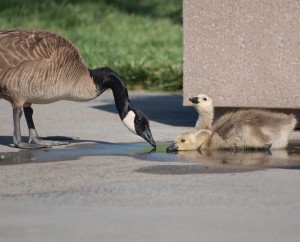
On a pond, I would have recognized the shapes and colors. Here, though, in just a few inches of water, at the intersection of heavily traveled asphalt footpaths on a university campus?
Ducks. A pair of mallards, heads tucked under wings.
I walked past, went thirty yards, then came back. A few feet away, I squatted down to look more closely. Noticing me, the ducks lifted their heads and quacked. As soon as I stood and moved off a few paces, they settled back into their afternoon nap.
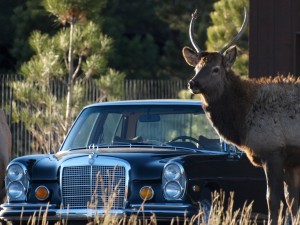
Something about the scene felt strange.
In part, it was aesthetic prejudice, the same kind of distaste I feel when I hear of bears habituated to pawing their way through landfills. In my imagination, wild ducks paddle along river banks and dabble among cattails. They don’t belong in asphalt-bordered puddles.
But something else bothered me, too. The mallards were completely unconcerned by the proximity of humans. Like zoo animals, they seemed to have lost their wildness.
What do we mean, though, when we say that creatures are “wild?”
Do we mean that they are wary of humans? That they see us as potential predators? Or, if large and carnivorous, as potential prey? Might there be a better, less anthropocentric, measure?
Are creatures who spend their lives in environments of human artifice—and who become accustomed to us in the process—still “wild?”
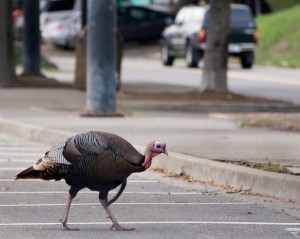
I wonder whether animals can feel it when their wildness slips away. I wonder whether they sense, as some humans do, that it leaves in its wake a forgetfulness—about who we are and where we belong.
And I wonder if wildness is ever truly driven out of any of us, or if it merely slumbers.
© 2010 Tovar Cerulli
A buck looks back: Quirk or gift?
Reaching my spot in the woods that morning, I had no illusions about my chances of seeing a legal buck.
My first three years, I had come up empty-handed. My fourth year, I had gotten lucky. This was my fifth year. Given that only one in eight Vermont hunters tags a whitetail each autumn, I had no right to expect that I’d bring home venison two years in a row.
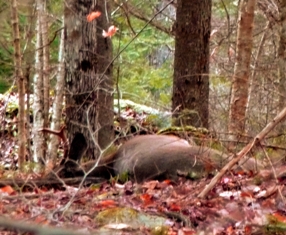 On opening weekend of rifle season, I had hunted almost every daylight hour. And I had seen more deer than usual: one doe and one young buck who was probably a spikehorn, both illegal under current regulations.
On opening weekend of rifle season, I had hunted almost every daylight hour. And I had seen more deer than usual: one doe and one young buck who was probably a spikehorn, both illegal under current regulations.
This morning, though, and for the rest of the 16-day season, I’d only get out for the odd hour or two: almost certainly not enough time for a buck to come my way. I set my pack on the ground and sat down, my back to the half-rotten stump of a fallen maple. It was already getting light, sunrise not far off.
Four minutes later, I heard a deer coming.
The hoof steps were to my right, my view blocked by the brushy branches of a fallen hemlock.
When I saw the buck, he was already close, moving at a brisk trot, and one glance told me he was no spikehorn. He was crossing the slope behind me. There was no way to turn without being seen. I had to hope he would cross all the way behind me and offer a shot to my left.
No such luck. Just fifteen yards away, he looked in my direction, wheeled, and charged back the way he’d come. Having nothing to lose, I stood and turned to watch him go. Even at that close range, I wasn’t going to shoot at a running deer; the chances of a wounding shot were too high.
Thirty yards off, he turned to look back. I knew he’d be there just a moment.
There was no time to think through the shot, let alone brace against a tree for the kind of steadied aim I prefer—I’m a slow, deliberate hunter, not a quick, offhand shooter. There was just that one second to bring the rifle to my shoulder, see that his shoulder and front ribs looked like a barn door (something I could hit), decide that the bullet’s path was clear of branches, and fire.
The buck dropped in his tracks and lay still.
I stood there, stunned: by how fast it had all happened and how unlikely it all seemed.
Naturally, it could be explained. As I hiked in—tromping through crunchy, frozen leaves, making more noise than a moose—the buck must have been too far away to hear me, or making too much noise himself. The timing was pure coincidence. And his almost immediate pause and backward glance—a common behavior among mule deer, I gather, but less usual among whitetails—must mean that he’d scented but not seen me, and was curious to know where I was.
But that isn’t the only way to see it. Many indigenous hunting cultures say that animals “offer” themselves as a “gift” to the hunter. From a Euro-American perspective, this sounds like mere metaphor, perhaps aimed at making humans feel better about killing. Of course animals don’t “give” themselves to hunters. How ridiculous.
Or is it?
In his article “The gift in the animal” (American Ethnologist, Vol. 34, No. 1, 2007), anthropologist Paul Nadasdy argues that aboriginal accounts of hunting might be literally true. Among other evidence corroborating the views of the Kluane of the Southwest Yukon, he recounts how a rabbit escaped from one of his snares, then tried to get into his cabin five days later, with the snare wire still around its neck. It made no effort to flee as he picked it up and killed it.
What if Nadasdy is right? What if the Kluane view of nature and animals is as valid as the one I grew up with? What if there was more than chance at work in my encounter with that buck, more than a quirk of curiosity in his fatal pause? How would that change my hunting and the meaning of it?
There are dangers, of course, in lifting concepts like “animal” and “gift” off the surface of another culture. It can be rather parasitic. And we’re unlikely to understand what the concepts mean in the depth of their original context.
So let’s bring it down to earth and closer to home.
In essence, northern hunting peoples such as the Kluane understand animals to be “sentient and communicative persons,” as Nadasdy puts it. They see animals as beings who deserve respect, who are capable of feeling, suffering, and consciously interacting with each other and with humans.
In our own culture, how might we—hunters and non-hunters alike—tackle the challenge implicit in that view? How might we hold both the concept of animals as conscious fellow creatures and the concept of animals as food?
Humans, after all, are like that, too: conscious (more or less), yet ultimately consumable. Recyclable.
© 2010 Tovar Cerulli
Feathers in the snow
First, a downy tuft. Then a barred tail feather. I scanned the path ahead and the woods to either side. Usually, when I find a few grouse feathers, there are more nearby, then more, then the spot where it happened.
This time, I did find more feathers, perhaps a couple dozen. But no epicenter.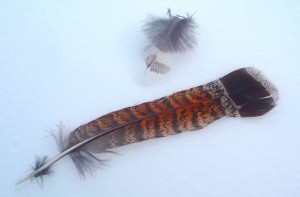
One tail feather, caught a few feet off the ground among the snow-laden branches of a hemlock sapling, suggested a dramatic scene: a hawk or owl swooping, taking its prey on the wing—or off a branch above—and carrying it off for dinner. That’s how most ruffed grouse go, snatched by a raptor.
I sympathize with both hungry predator and wary prey, and am awed by both: the powerful strike of one bird, the subtle camouflage and evasive maneuvers of the other.
These kinds of predatory encounters happen all the time—birds, bugs, fish, amphibians, reptiles, and mammals eating each other constantly. Yet, in our daily lives, we rarely see such nutritional transactions. And in our animated films—pale, distorted parables of nature that they are—animals rarely eat; miraculously, predators and prey become buddies.
It’s easy to forget about all the eating. Like the raptor swooping overhead, prey in talons, it hardly touches the ground of our consciousness.
When our thoughts do turn to nature and eating and humans, we know where we stand. At the top. You’ve probably seen the slogan on T-shirts and bumper stickers: “I Didn’t Claw My Way to the Top of the Food Chain to Eat Vegetables.”
It’s quite a fantasy—linear, neatly avoiding the cyclical truth of our own mortality. For we, too, are part of nature. We’re like the large carnivores who “in the end,” as Paul Shepard once put it, “are pursued by microbes, fungi, and plant roots.”
If you stop to think about it, there’s beauty here. The nutrients of our bodies becoming part of field, forest, and stream. Perhaps part of grouse or hawk, or drawn up into the stem and needles of the small hemlock where the grouse feather alights.
Omnivorous predator though I am, I think the T-shirt should read: “I Clawed and Clawed But Couldn’t Escape the Food Web – Soon I’ll Be Feeding Vegetables.”
© 2010 Tovar Cerulli
